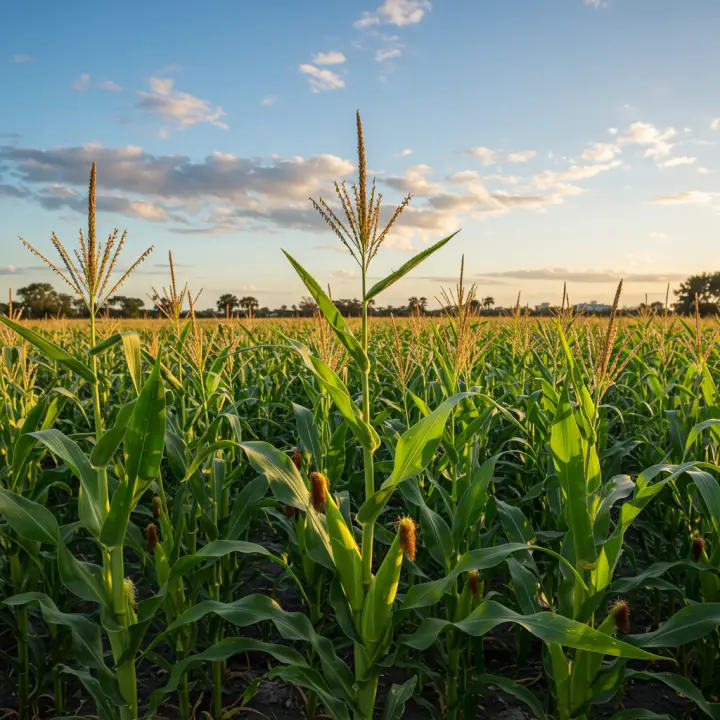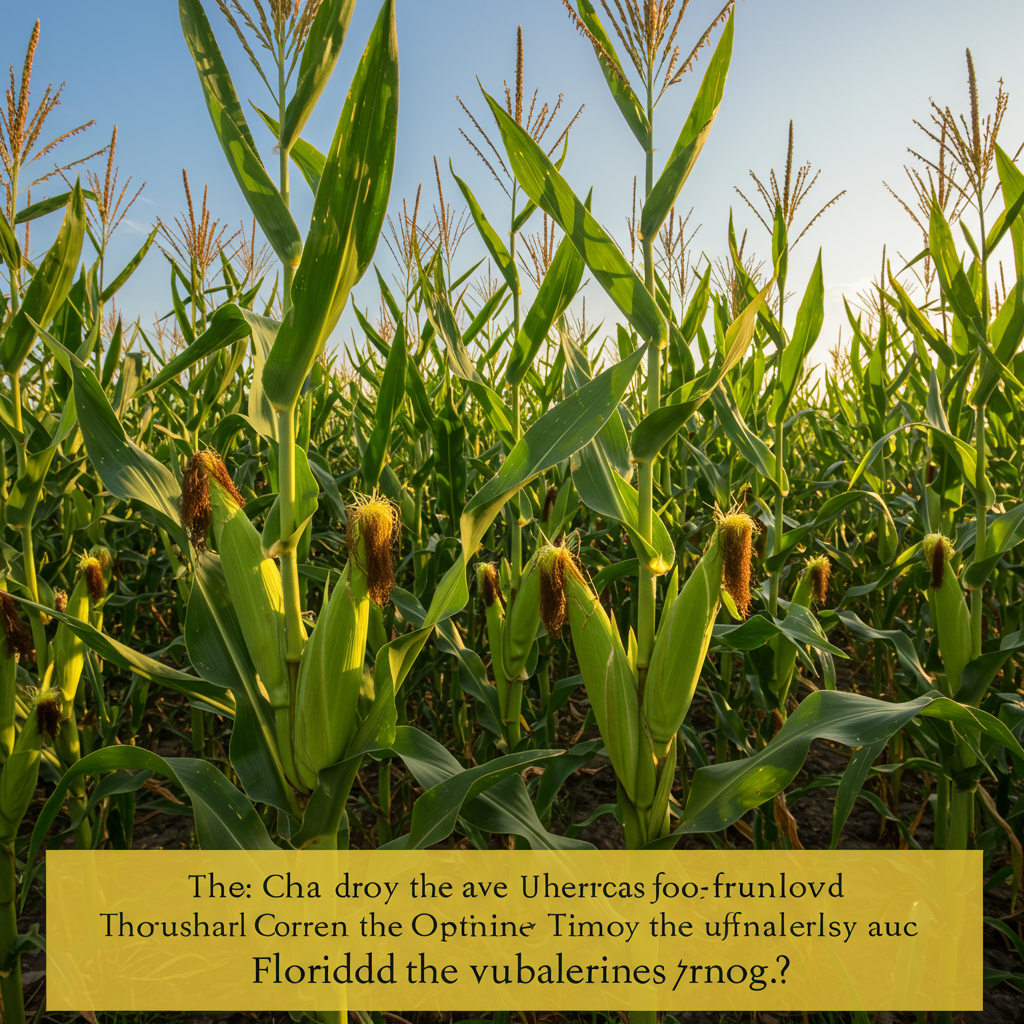Knowing the best time for Florida corn planting is crucial for maximizing yield and minimizing issues. This comprehensive guide covers ideal planting dates, soil preparation, fertilization, pest management, and harvesting to ensure a successful corn crop in Florida’s unique climate.

Introduction: Sowing the Seeds of Success in Florida
Florida’s warm and humid climate presents unique opportunities and challenges for corn growers. While the extended growing season allows for multiple harvests, careful planning and execution are essential to avoid issues related to pests, diseases, and extreme weather. Understanding the optimal planting window is the first step towards a bountiful harvest. This guide delves into the intricacies of Florida corn planting, providing you with the knowledge to cultivate a thriving crop.
When to Plant Corn in Florida: Decoding the Optimal Window
The ideal planting time for corn in Florida varies depending on the region and intended use. Generally, there are two main planting seasons:
Spring Planting (February – March in South Florida, March – April in North Florida): This is the most common planting season for field corn destined for grain production. Planting early allows the corn to mature before the hottest and wettest parts of summer, reducing the risk of fungal diseases and insect infestations.
Fall Planting (August – September): This season is suitable for sweet corn and silage production in some areas. Fall-planted corn may benefit from milder temperatures during the critical pollination stage. However, it’s crucial to choose varieties that can withstand potential early frosts.
Soil Preparation: Laying the Foundation for Healthy Growth
Proper soil preparation is paramount for successful corn production. Florida soils vary greatly, ranging from sandy coastal soils to heavier inland soils. Regardless of soil type, the following steps are crucial:
Soil Testing: Get a soil test to analyze nutrient levels and pH. This information will guide your fertilization strategy and ensure optimal growing conditions.
Tilling: Tilling helps break up compacted soil, improves drainage, and incorporates organic matter.
pH Adjustment: Corn thrives in slightly acidic soil with a pH between 6.0 and 6.8. Lime can be added to raise the pH if necessary.
Organic Matter Incorporation: Adding compost or other organic matter improves soil structure, water retention, and nutrient availability.
Choosing the Right Corn Variety: A Match Made in Florida
Selecting the right corn variety is crucial for maximizing yield and disease resistance. Consider these factors when choosing a variety:
Maturity Group: This indicates the number of days required for the corn to reach maturity. Choose a maturity group that aligns with your planting window and desired harvest date.
Disease Resistance: Select varieties resistant to common Florida corn diseases, such as Southern corn leaf blight and common rust.
Intended Use: Choose varieties specifically bred for grain production, sweet corn, or silage, depending on your needs.
Fertilization: Nourishing Your Corn Crop
Corn is a heavy feeder and requires adequate nutrients for optimal growth. A balanced fertilization program is essential, incorporating:
Nitrogen: Essential for vegetative growth.
Phosphorus: Crucial for root development and early growth.
Potassium: Supports overall plant health and disease resistance.
Apply fertilizer based on soil test recommendations. Split applications are often recommended, with a portion applied at planting and the remainder applied as a side-dressing when the corn is knee-high.
Irrigation: Watering for Optimal Growth
Consistent moisture is essential for corn, especially during critical growth stages like pollination and grain fill. Consider these irrigation strategies:
Drip Irrigation: Delivers water directly to the roots, minimizing water waste and promoting efficient uptake.
Sprinkler Irrigation: Suitable for larger fields, provides uniform water distribution.
Rainfed Production: Possible in areas with sufficient rainfall, but requires careful monitoring of soil moisture.
Pest and Disease Management: Protecting Your Investment
Florida’s warm and humid climate can create favorable conditions for pests and diseases. Implement a proactive pest and disease management plan to protect your crop:
Scouting: Regularly inspect your field for signs of pests and diseases.
Integrated Pest Management (IPM): Utilize a combination of cultural practices, biological control, and targeted pesticide applications to manage pests effectively.
Disease-Resistant Varieties: Planting disease-resistant varieties is the first line of defense against fungal and bacterial diseases.
Harvesting: Reaping the Rewards of Your Labor
The optimal harvest time depends on the intended use of the corn:
Grain Corn: Harvest when kernels are hard and dry, typically around 18% moisture content.
Sweet Corn: Harvest when kernels are plump and milky, typically 18-21 days after silking.
Silage Corn: Harvest when the whole plant is at the optimal stage for fermentation, usually around 65-70% moisture content.
FAQs: Addressing Common Concerns
Q: Can I grow corn in my backyard in Florida?
A: Yes, you can grow corn in your backyard, provided you have adequate space and sunlight. Choose smaller varieties suitable for container gardening if space is limited.
Q: How much water does corn need in Florida?
A: Corn typically needs about 1-2 inches of water per week, depending on the weather and soil type.
Q: What are the common pests affecting corn in Florida?
A: Common pests include corn earworm, fall armyworm, and aphids.
Q: How do I know when my sweet corn is ready to harvest?
A: Check the silks – they should be brown and dry. Puncture a kernel with your fingernail; if the liquid is milky, the corn is ready.
Q: What are some good corn varieties for Florida?
* A: Recommended varieties vary based on your location and intended use. Contact your local extension office for specific recommendations.
Conclusion: Harvesting Success Through Knowledge and Planning
Growing corn in Florida presents unique challenges and rewards. By carefully considering the factors discussed in this guide – timing, soil preparation, variety selection, fertilization, irrigation, pest management, and harvesting techniques – you can maximize your chances of a successful and bountiful corn harvest. Remember to stay informed about local conditions and adapt your practices accordingly to ensure effortless growth and achieve optimal yields from your Florida corn crop. Happy planting!

